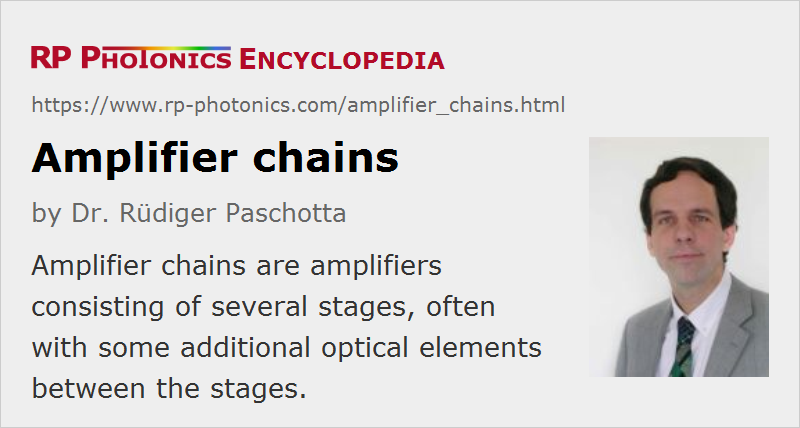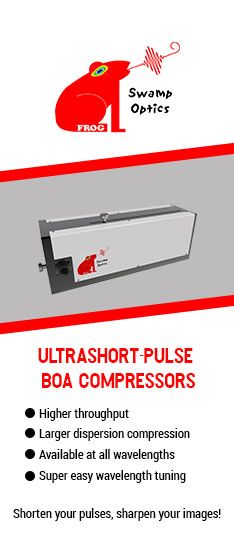Amplifier Chains
Definition: amplifiers consisting of several stages
German: Verstärkerketten, Verstärkerkaskaden
How to cite the article; suggest additional literature
Author: Dr. Rüdiger Paschotta
An amplifier chain is a sequence of several amplifiers, which can subsequently amplify some signal. The first stage is often called the preamplifier and the last stage a power amplifier. Such schemes are common in electronics, but also in laser technology (as considered here), because the concept of an amplifier chain can have advantages compared with an approach where the full performance in expected from a single amplifier stage:
- There are certain trade-offs, for example between obtaining a high saturated output power and a high gain. For example, a high saturated output power calls for a large mode area in the last section of the amplifier, while the preamplifier can have a better gain efficiency when the mode area is chosen small. The overall performance can then be improved by splitting the amplifier into different amplifier stages which can be independently optimized. In ultrashort pulse amplifiers, the power amplifier may also need increased mode areas for reducing nonlinear effects. It is also possible to combine different kinds of amplifiers, e.g. a regenerative amplifier as a high-gain preamplifier and a multipass amplifier as a power amplifier with moderate gain, or an optical parametric amplifier with a laser amplifier.
- Sometimes it is necessary to insert certain optical elements between different stages of an amplifier chain. For example, in many high-gain amplifiers an optical isolator between the stages reduces the sensitivity to ASE and back-reflections. A bandpass filter can strongly reduce the total ASE power for both propagation directions. In amplifiers for ultrashort pulse amplification, an optical modulator (e.g. an acousto-optic modulator) between the stages may be opened only for some short time interval during which a pulse is transmitted to the next stage.
- The use of amplifier chains allows for a more modular approach where different performance numbers can be obtained simply by differently combining existing amplifier stages (modules).
Questions and Comments from Users
Here you can submit questions and comments. As far as they get accepted by the author, they will appear above this paragraph together with the author’s answer. The author will decide on acceptance based on certain criteria. Essentially, the issue must be of sufficiently broad interest.
Please do not enter personal data here; we would otherwise delete it soon. (See also our privacy declaration.) If you wish to receive personal feedback or consultancy from the author, please contact him e.g. via e-mail.
By submitting the information, you give your consent to the potential publication of your inputs on our website according to our rules. (If you later retract your consent, we will delete those inputs.) As your inputs are first reviewed by the author, they may be published with some delay.
See also: optical amplifiers, multipass amplifiers, regenerative amplifiers, amplified spontaneous emission
and other articles in the category optical amplifiers
 |





If you like this page, please share the link with your friends and colleagues, e.g. via social media:
These sharing buttons are implemented in a privacy-friendly way!